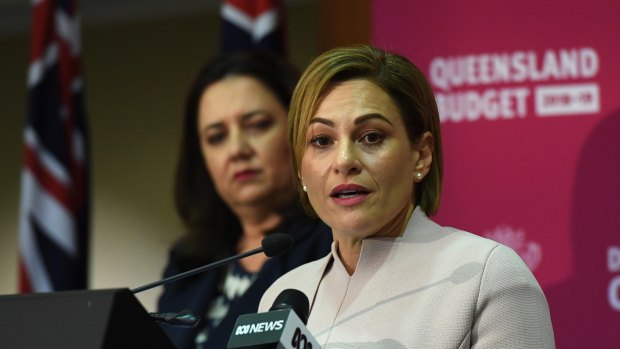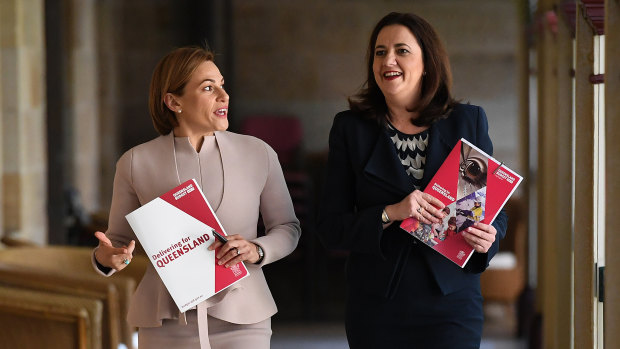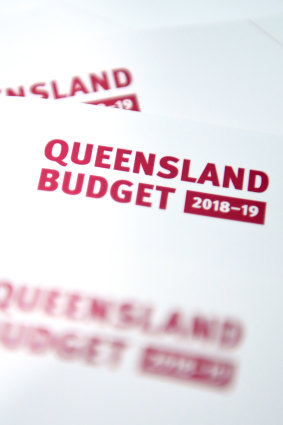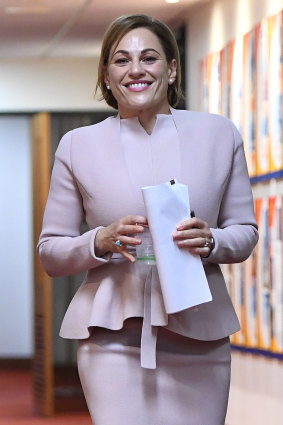This was published 7 years ago
Queensland budget 2018: Coal comfort for now but debt set to blow out
• Full Queensland budget 2018 coverage
Coal has stoked the Queensland budget with a massive lump of cash, while five new taxes will rake in more than $650 million by 2021-22.
Delivering her first budget as Treasurer, and the fourth for the Palaszczuk government, Jackie Trad unveiled a $1.512 billion surplus in 2017-18 - more than three times the forecast in the Mid Year Fiscal and Economic Review in December.

Queensland Premier Annastacia Palaszczuk (left) and Treasurer Jackie Trad prepare to hand down the 2018-19 budget. Credit: AAP/Dan Peled
That was $1.37 billion more than predicted in last year's budget under former treasurer Curtis Pitt.
The significant boost was attributed to short-term factors, such as more royalty revenue because coal prices remained higher for longer than expected and increased Australian government grants thanks to a larger GST pool.
Royalties and land rents were estimated to have contributed a $4.48 billion windfall to Queensland in 2017-18 - about $1 billion higher than predicted in last year's budget.
The strong surplus means general government sector debt in 2017-18 would be about $2.4 billion less than estimated in last year's budget.
But coal prices were expected to be less lucrative over the medium term and an anticipated reduction in GST revenue - with a reduction of about $749 million over the forward estimates since MYFER - meant future years remained challenging.
As a result, a much smaller $148 million net operating surplus was predicted for 2018-19.
In 2018-19, general government sector debt was expected to be $32.31 billion, $4.10 billion lower than forecast in last year's budget.
Non-financial public sector debt, which includes government-owned businesses, was expected to be $70.87 billion over the next year.
Total debt was forecast to increase and hit $83.09 billion by 2021-22.
"We are borrowing to build the infrastructure that our state and our communities need, whether that's the Townsville stadium in north Queensland, whether it's the M1 projects," Ms Trad said.

Treasurer Jackie Trad and Queensland Premier Annastacia Palaszczuk arrive for the budget media lockup.Credit: AAP
"Our debt levels are some $17 billion less than they were predicted under the LNP."
The debt-to-revenue ratio fell to 54 per cent in 2017-18, primarily as a result of the large surplus, but it was significantly lower than the peak of 91 per cent in 2012-13.
Total general government sector expenses were expected to be $57.59 billion in 2018-19, an increase of $843 million (1.49 per cent) on the amount spent over the past year.

Queensland's 2018/19 state budget booklets.Credit: AAP
"We know we have to exercise discipline around our spending and that's what we're doing in terms of recurrent expenses," Ms Trad said.
Ms Trad said the increase in government spending was due to various decisions, such as joining the National Redress Scheme at a cost of $500 million.
Expenses also grew because of spending on health and education, job-creation programs such as Works for Queensland and advanced payments to councils for the introduction of the new waste disposal levy.
The total general government sector revenue was estimated to be $57.74 billion in 2018-19, a decrease of half a billion from last year as a result of reduced Australian government grants and lower dividend and income tax equivalent income.
But offsetting the decline would be a 6.6 per cent growth in tax revenue, including growth in payroll tax and land tax base and a new waste levy.
This year's budget will include five new or increased taxes, including the waste levy which was not flagged at the November election, and an extra tax on luxury cars, with all five expected to reap $299.97 million in 2018-19.
But the revenue from a 15 per cent charge on bets placed with companies based in the Northern Territory could bring in less than the $70 million predicted, owing to negotiations with UBET.
By 2021-22, the five taxes were expected to bring in more than half a billion dollars in one year.
Pokies would bring in $750 million in 2018-19, while vehicle registration fees were expected to rake in $592 million.

Ms Trad said her first budget was an "infrastructure budget".Credit: AAP
But the government would move to a CPI-based increase of fees for charges such as car registration and licence fees by 2019-20, instead of a 3.5 per cent indexation rate, which would mean $53 million less in revenue in 2020-21.
Payroll tax was expected to rake in $4.08 billion in 2018-19, growing 5.1 per cent on the previous year.
Ms Trad was keen to spread the message that hers was an infrastructure budget, with the largest capital works program since the 2011 flood recovery, funded by surpluses and borrowings.
There would be $45.8 billion in infrastructure spending over the next four years, about $3 billion more than pledged during last year's budget.
Major projects would be the $5.4 billion Cross River Rail, M1 upgrades and Sunshine Coast rail line duplication, while 65 per cent of infrastructure funding would be outside of the Greater Brisbane area.
"We will put the brakes on economic growth if we don't actually invest in infrastructure," Ms Trad said.
Ms Trad denied there was a cut in infrastructure spending in this year's budget, with half a billion less allocated in the government sector in 2018-19 than forecast in last year's budget.
"Our infrastructure spend is over four years ... infrastructure projects, in terms of costings, change from estimate to actual," she said.
The unemployment rate was forecast to remain at 6.25 per cent in the June quarter 2018 and 2019, higher than predicted last year, before falling to 6 per cent by June 2020.
Economic growth was forecast to accelerate from 2.5 per cent in 2016-17 to 3 per cent by 2018-19.
The public sector, excluding Queensland Health, would be asked to save $1.02 billion over the forward estimates in a measure called "reprioritisation", but this would not include the sale of "strategic income-earning assets" or forced redundancies.
The Palaszczuk government committed to keeping the growth in the ballooning public service to population growth.
The public service would grow by 1.71 per cent in 2018-19, with the majority of new jobs in education and health, with employee expenses and superannuation to cost $27.36 billion - about 47 per cent of total expenses.
Over the forward estimates, the full-time growth in public service was expected to track at 1.71 per cent, compared with population growth at 1.75 per cent each year.
Employee expenses were expected to grow by 4.5 per cent over the five years to 2021-22.
The government's electricity, rail, ports and water businesses were expected to earn $3.97 billion before interest and tax next year.
Education and training would get more than $14 billion this year, while Queensland Health would get $17.3 billion.
The Queensland Transport and Roads Investment Program would get $21.7 billion over the next four years, an increase of about $700 million on last year's commitment.
The 50 per cent payroll tax rebate scheme will be extended until June 2019, to support 26,000 apprentices and trainees.
Visit Brisbane Times Facebook page from 5pm for a live chat with our state political reporter Felicity Caldwell and senior reporter Tony Moore.